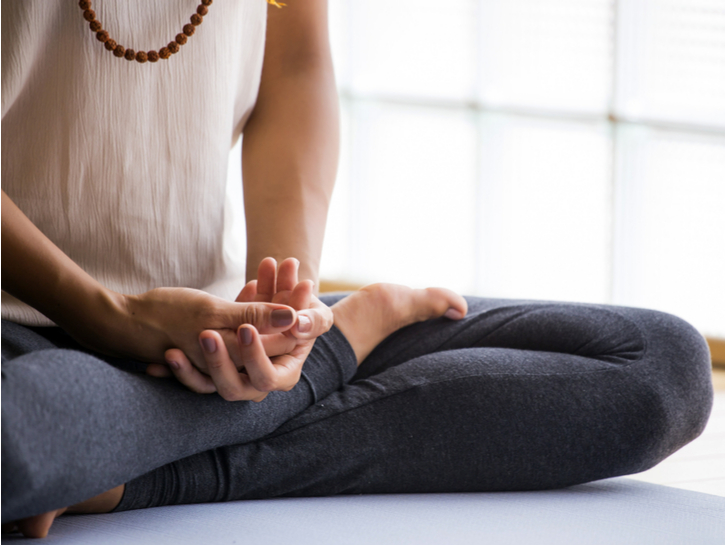Meditation has been practiced for thousands of years, originating in South Asia as far back as 5,000 to 3,500 B.C. The practice was originally done for religious reasons and spiritual development. For example, those who practice Buddhism strive to achieve a path to Enlightenment, and meditation is one way to get closer to this goal.
But as centuries have past and meditation has been introduced to more and more cultures, the practice has been implemented for many different reasons. Today, many Westerners practice meditation to promote their overall well-being, and meditation has been linked to many physical and emotional benefits.

Evgeny Atamaneko/Shutterstock
What Are The Types Of Meditation?
Guided Meditation
This method of meditation engages your senses as you form mental images of a relaxing environment — think, “going to your happy place.” Often through the help of a guide, you visualize the sights, sounds, smells and textures of the world you are imagining, whether it’s a sunny beach or lying in a meadow under a night sky.
Mantra Meditation
During this method of meditation, you focus on a mantra — a repeated sound, word or series of words. Mantra meditation originated in Buddhism and Hinduism with the simple mantra Om. The purpose of mantra meditation is to focus on a calming sound, word or phrase to prevent distracted thoughts from entering your mind.
Mindfulness Meditation
Mindfulness is the practice of being aware and accepting of the present moment, without constantly concerning yourself with the past or future. Instead of a mantra or relaxing imagery, you focus on yourself at that moment by concentrating on the flow of your breath. When distracting thoughts arise, acknowledge them and let them pass so you bring your focus back to breathing.
Yoga
Yoga is a combination of meditation and physical exercise. Using slow, deliberate and controlled movements, you flow through a series of postures that help build strength, balance, and flexibility while focusing on your breathing. Yoga is great meditation because you focus on the present moment and aligning your movements with your breath. The practice often follows with Shavasana, a time when you rest in corpse pose and meditate.

Luna Vandoorne/Shutterstock
How Can I Get Started?
Incorporating meditation into your life doesn’t need to be complex. You don’t need to put on music or light candles or use essential oils. All you need to do is take a few moments out of your day to center yourself and breathe free of distractions.
If you’re looking to begin practicing meditation, all you need is a still place where you can sit or lie down comfortably (no, you don’t need to cross your legs and sit in the lotus position). Close your eyes and draw your attention to your breath, taking note of how your body is moving as you breathe. Notice the rise and fall of your chest and stomach. Count the length of your breaths. If you get distracted, bring your mind back.
There are also apps you can download to get you started, including Calm, buddhify and Insight Timer.

wavebreakmedia/Shutterstock
What Are The Benefits Of Meditation?
Mental And Emotional
Meditation is known for improving emotional well-being and managing symptoms of mental illnesses such as anxiety, depression and PTSD. There have been many studies suggesting the positive impact meditation has on mental health. One such study published in Biological Psychiatry found that regular mindfulness meditation caused significant changes in the parts of the brain linked to processing stress, focus, and calmness.
Other emotional benefits of meditation include:
- Stress management
- Increasing self-awareness
- Focusing on the present
- Reducing negative emotions
- Increasing imagination, creativity, patience and tolerance
- Gaining new perspectives on stressful situations

sun ok/Shutterstock
Physical
The benefits of meditation aren’t confined to managing mental health — meditation has been linked to helping your physical well-being as well. Consistent meditation has been linked to improving:
- Chronic pain
- Substance abuse
- High blood pressure
- Heart disease
- Irritable bowel syndrome
- Sleep disorders
- Tension headache

Antonio Guillem/Shutterstock
Busting Meditation Myths
If you’ve never meditated before, it’s important to address any misconceptions that you might have about the practice so they don’t stand in your way. Here are some common myths about meditating:
Myth: You Don’t Need To Be In The Lotus Pose
When you picture someone meditating, your mind might immediately go to being cross legged, hands resting on your knees and the tips of your thumb and pointer fingers touching. While you certainly can choose to be in the lotus pose during meditation, this might be an uncomfortable position to hold for some people, especially beginners. In truth, you don’t need to be sitting like this — you don’t even have to be sitting at all. You can assume any position that is comfortable to you during your practice, whether that be sitting in a chair, resting against a wall or lying down flat on your back.
Myth: Meditation Is Not About Clearing Your Mind
Many people might be intimidated about the feat of keeping a clear mind for an extended amount of time, but that’s not what meditation is about. During meditation, you focus on your breath, mantra or guided imagery. If your mind begins to wander, acknowledge it without judgment and bring yourself back to your point of focus. Your mind shouldn’t be a blank slate. If you try meditating and find your mind wandering a lot, don’t get discouraged — as with anything, meditation takes practice.
Myth: You Must Remain Absolutely Still
This is also untrue. Although you want to completely relax your body, if you find your position growing uncomfortable you should definitely make small adjustments to achieve relaxation. Don’t think that you have to remain a statue during your practice. Minor adjustments to a better position will remove the distraction of your discomfort and help you get back to your point of focus.
